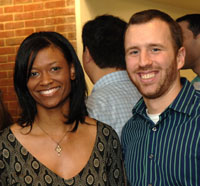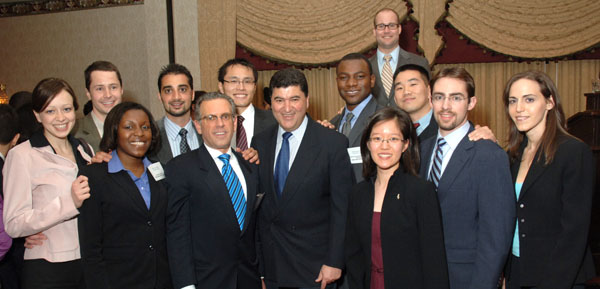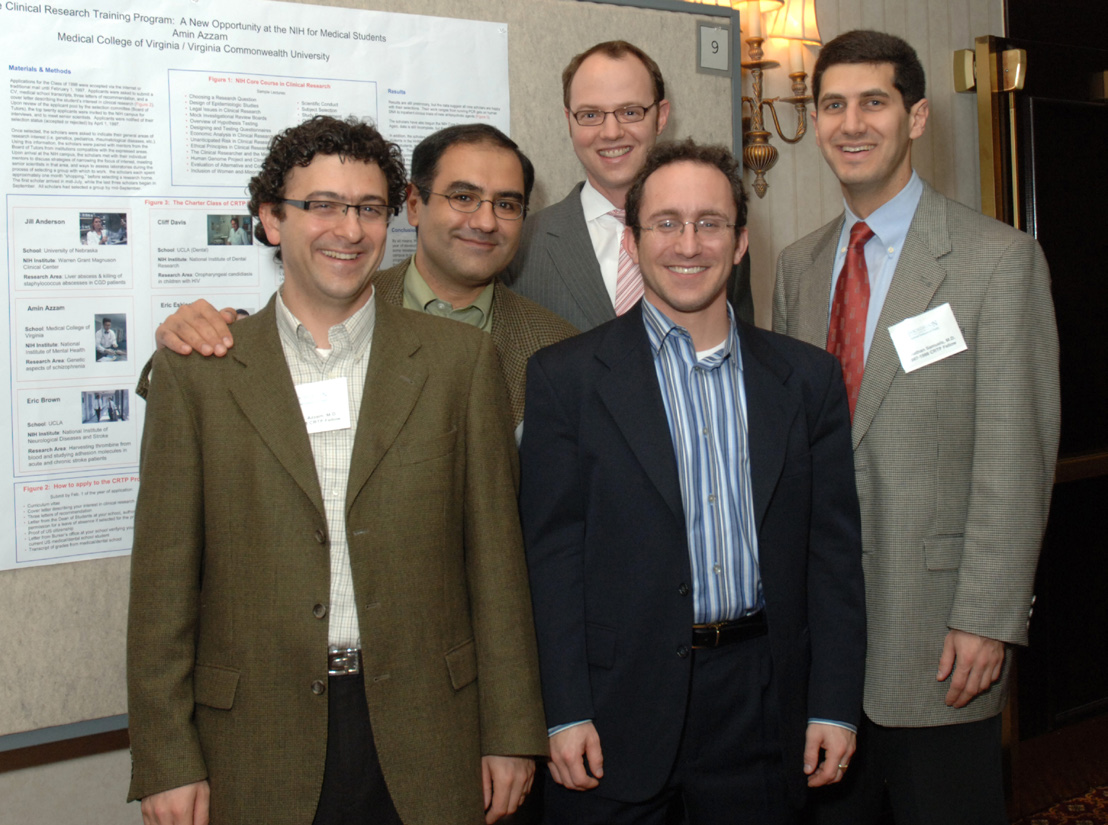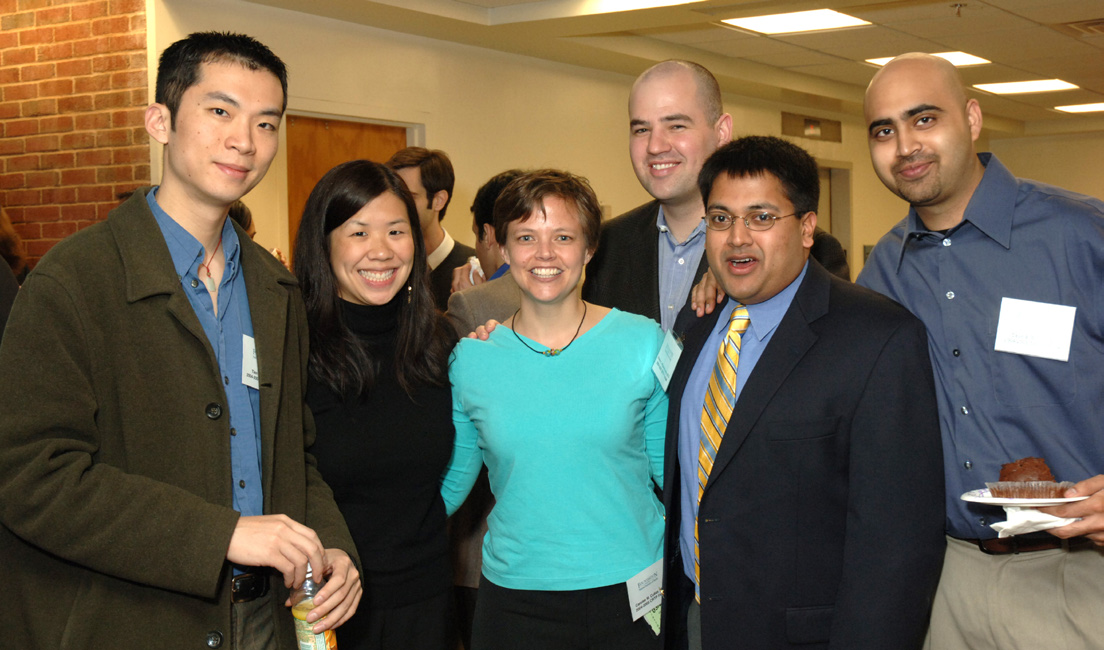| |
 |
|
|
|
|
| |
From the class of 2003-04 are Drs. Porcia Bradford and Mark Naftanel. |
|
“You are the people who will form the bridge and provide the most valuable part of translational
medicine. You are the vanguard of innovation in health,” said Dr. Elias Zerhouni, NIH director, speaking
to alumni and current fellows in the NIH Clinical Research Training Program (CRTP). He presented the keynote address during a dinner that capped the program’s 10-year reunion recently.
“What is important in life is not what organization
you belong to, but the values that you hold. If the values are there, things will happen,” he said, expressing appreciation to the fellows for “translating their passion for clinical research, which is critical to the well-being of humankind, for the benefit of others in the world.”
According to Zerhouni, the CRTP’s strengths include creating friendships and networks that will last a lifetime, uniting “like minds with like values coming together for something greater
than themselves,” and providing a “thinking space” with mentors and facilities to encourage
scientific innovation. He advised the group to “remember key mentors” and to have the courage to take risks to follow their dreams. “You never know what turns your life will take, if you’re willing to take a path that no one else will take.”
Earlier in the day, the group heard updates on the clinical and translational research agendas
from the directors of the CC, NIAID, NIDDK,
NHGRI, NIMH and NCRR. “Opportunities shape your career as much as your planning,” said Dr. Anthony Fauci, NIAID director, describing
how he could not have predicted his future involvement in emerging infectious disease threats, such as HIV/AIDS, when he first came to NIH.
 |
| Members of the 2005-2006 class meet NIH director Dr. Elias Zerhouni (c). Shown are (from l) Alison Rager; Bryan Traughber; Ezinma Achebe; Mehrdad Alemozaffar; CRTP director Dr. Frederick Ognibene; Tony Wang; Obinna Emechebe-Kennedy; Lan Chang; Clint Allen; Frank Hwang; Richard Robison and Veronique Nussenblatt. |
Numerous CRTP alumni took to heart the quote NHGRI director Dr. Francis Collins shared at the conclusion of his presentation: “As for the future, your task is not to foresee, but to enable it,” he said, citing Antoine de Saint-Exupery.
Reflecting on how things have changed since the first class came to campus, Dr. John Gallin,
CC director, traced Clinical Center accomplishments
that have occurred since the birth of the CRTP 10 years ago, noting “this has been an era of extraordinary growth and transition.”
Milestones include celebration of the CC’s 50th anniversary in 2003, opening of the Mark O. Hatfield Clinical Research Center in 2004, responses to the Katrina disaster in 2005 and opening the metabolic clinical research unit earlier
this year.
During the reunion weekend’s alumni panel on career development post-CRTP, several panelists
echoed Fauci’s emphasis on opportunities the program offers for professional growth. Dr. Lynn Henry (1999-2000) said she came to the program thinking she wanted to work in infectious
diseases. Exposure to various clinical and translational research opportunities as a fellow
led her in a different direction. She’s now a hematology/oncology fellow at the University of Michigan Comprehensive Cancer Center.
“I don’t think I could have planned a more perfect
route, and 9 years ago I wouldn’t have guessed that this would be my research,” said Dr. Stacy Suskauer (1998-1999), pediatric rehabilitation
fellow at the Kennedy Krieger Institute
and Johns Hopkins School of Medicine.
“At some point, you have to bring up the younger
generation of clinical researchers, which is why we have this fabulous program,” said Dr. Stefan Weiss (1999-2000), senior medical director
at Connetics Corp. He described his “alternative
track,” beginning with work as a CRTP fellow with Dr. Ezekiel Emanuel, chief of the CC clinical bioethics department, followed by specialization
in dermatology and learning business development in the pharmaceutical industry.
Nine former CRTP fellows have returned or will return to NIH for additional fellowship programs or post-residency training in NCI, NINDS, NIAID and the CC. Dr. Michael Dimyan (2000-2001), currently a clinical fellow in neuro-
rehabilitation at the NINDS human cortical physiology section, recently submitted a paper based on work begun during his CRTP experience.
Dr. Porcia Bradford (2003-2004), who will return to NIH in July as a fellow in NCI’s Division
of Cancer Epidemiology and Genetics, said she particularly enjoyed touring the new hospital
and reuniting with medical school colleagues and NIH mentors.
Several fellows credited CRTP with helping create
contacts and networks that are still fruitful today. Dr. Jonathan Samuels (1997-1998), assistant
attending physician and clinical instructor in medicine for the division of rheumatology at New York University Hospital for Joint Diseases,
described a current collaboration with a colleague
he met at NIH who is now in Oklahoma. Dr. Uri Lopatin (1997-1998), associate director,
hepatology branch, Schering-Plough, called CRTP a “great learning experience with fabulous role models and mentors that creates a network of people,” many of whom remain in contact years later. The experience is “very enabling for those who begin a very long, difficult road. It’s an invaluable resource to have a community of peers. It’s a wide, wide world full of really smart people who all have something to offer the clinical
endeavor.”
During informal discussions throughout the reunion, alumni from the early days offered advice about what to consider before and after fellowships and residencies. Discussions also focused on how NIH might expand the CRTP for future generations, including the possibility
of longer “tune-up” sessions to deconstruct clinical projects or focus on grant-writing skills, continued mentoring and improved mechanisms
to support the transition from fellowship to an independently funded investigator.
At the keynote dinner, former Rep. John E. Porter,
vice chair of the board of directors for the Foundation for NIH, acknowledged the “risks and real sacrifices” made by the fellows to pursue their vocation of helping patients. “The Foundation
for NIH takes pride in your persistence and the excellence of your work,” he said, adding that scientists have the utmost of America’s respect. Pfizer chief medical officer Dr. Joseph Feczko praised the endurance and expansion of CRTP. “Seeing the success of this—where you’ve all ended up or are going—is a tremendous credit to you and to this program,” he said.
FNIH and Pfizer Inc. sponsored the reunion. Seventy CRTP alumni attended, along with most participants in the current class of 30.
 |
 |
| Top:
Members of the 1997-1998 founding class (from l) Drs. Amin Azzam, Eric Eskioglu, David Robbins, Uri Lopatin and Jonathan Samuels stand before their poster at a dinner for CRTP alumni sponsored by the Foundation for NIH and Pfizer Inc.
Bottom: Returning CRTP classmates from 2004-2005 are (from l): Drs. Tien Peng, Chris Keh, Carolee Cutler, Stefan Kachala, Rohan Wijewickrama and Dave Roy. |
CRTP History at a Glance
One hundred and ninety medical and dental
students have participated in the Clinical Research Training Program since it was established
in 1997. Former NIH director Dr. Harold
Varmus initiated the program to provide creative, research-oriented students with an opportunity to become involved in clinical research early in their careers. According to Dr. Frederick Ognibene, director of the CC Office of Clinical Research Training and Medical
Education and of CRTP, “During the CRTP year, the students learn the principles of clinical
research and conduct
either clinical or translational research alongside energetic NIH investigators who serve as mentors. It’s truly a life-changing experience that would be hard to replicate elsewhere.”
CC director Dr. John Gallin chairs the 30-member board of tutors, NIH principal investigators who assist in the review, interview
process and selection
of candidates and serve as advisors for students during their research year. Support from Pfizer Inc. allowed the program to grow to 15 students annually starting with the 1998-1999 class. The company renewed its commitment
four times; most recently in late 2006 for another 3-year cycle.
“The partnership between Pfizer and the Foundation
for NIH extends back to 1998—nearly to the birth of the Foundation—and includes contributions, pledges and in-kind gifts totaling $38.9 million, including $7.4 million in support of CRTP,” said Amy McGuire, executive director of FNIH.
In 2004, the NIH Roadmap provided additional
funds and allowed the program to increase in size from 15 to 30 students. The current class is the third to include 30 students. 